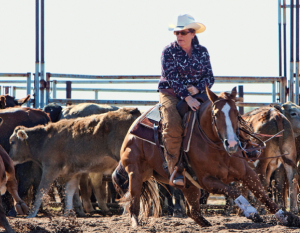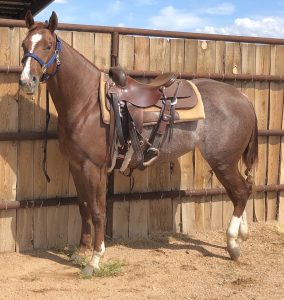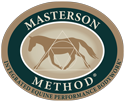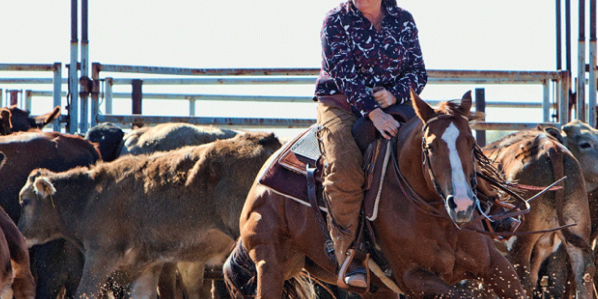By Lisa Haldane, MMCP and owner of Avalon Performance Horse and Rider Support
As many of you know I got certified as a Masterson Method practitioner in 2009 and started teaching weekend seminars over the next few years. Later I developed the online courses that are now offered through Avalon Performance Horse and Rider Support to help support the background and continuing education needs of the Masterson students such as the Equine Anatomy And Health Considerations Online Course.

My purpose through it all, in addition to education, was to help our own cutting horses to feel their best in a very challenging event and environment. It took 11 years, but the effort has been worth it! I wanted to share some things about cutting horses and their life that I hope will be useful to you if you decide to venture into this area of work. This will be the first in a short series where I’ll introduce you to the environment and schedule of the horses, what happens at the shows, and lastly, the progression in physical development of the young cutting horse.
Our horses have been involved primarily in four different training programs which have been pretty similar in terms of the daily routine:
At the training facility
- Morning feeding between 4 and 6 am with supplements
- Riding 5-6 days/week starting in the early morning with sessions lasting approximately 30 minutes
- Mid-day feeding around noon
- Turnout for a couple of hours several days per week if not every day
- Evening feeding between 4 and 6 pm
- Therapies administered in the afternoon or evening which can include PEMF Magna Wave, ice leg wraps or salt water spa, laser blankets and wraps, Bemer blankets, vibrating plate machines, freeze mud, chiropractic and bodywork with occasional osteopathy (there are not many osteopath practitioners in the cutting world).
At the show
- Feeding routine is the same
- No turnout
- Therapies and bodywork as deemed necessary but almost every horse gets iced or cold water spa therapy
The shows typically range from one to five days and horses may show all or part of those days, once or twice a day. The preparation to show typically involves 30 to 90 minutes of intensive warmup and a pre-class practice session on live cattle or a mechanical cow (called a flag). The actual competition lasts 2 ½ minutes. Once the class has ended, the horse is cooled out, washed, dried, and returned to its stall.
The horses work hardest at the shows and are very quiet in their stalls as they’ve expended a lot of energy during the day.
With this routine in mind, when is the best time for a bodyworker to enter into the picture? In my opinion late afternoons and evenings are the quietest time for the horse both at home and at the show, after the evening meal. At this time the barn has settled down for the day, many people have left the barn, and the horses have had time to rehydrate and rest from their exertions.
Bodywork practitioners are not as prevalent in this sport as are the electronic/magnetic/mechanical therapies. The current most prevalent therapy is the PEMF machine (MagnaWave is a common one) that uses a magnetic ring to run current through the muscles at varying frequencies. The feedback I get from trainers is that they don’t necessarily feel a difference from bodywork, and this can be frustrating but I’ll give you some thoughts on why I think that is.
In speaking with vets on the PEMF type therapy (excepting the BEMER), I think it’s possible that it has an analgesic effect (takes away pain) for the short term. This is confirmed by the MagnaWave literature, along with other benefits that are described. If reapplied daily or several days a week, then pain is relieved often. In theory this would be great, but it’s also possible that there are areas of discomfort that are not being recognized until there is an actual injury. It’s possible for a trainer to feel that there is a benefit because the horse is able to work with less resistance or unsoundness in the short term until there is a failure of the stressed area
I can tell you from my first-hand experience in riding and showing our horses that I can definitely feel the difference when I do Masterson sessions on them. I can also detect discomfort long before actual lameness shows up. I have done some recent experiments with checking for muscular tightness and restrictions before and after the non-Masterson therapies, and find little to no improvement in range of motion or release of tension from non-Masterson modalities. I did find, though, that after their other treatments the horse’s bodies were very ready to release and relax, they just needed that extra help that the Masterson work provides.
In my opinion the Masterson Method is best applied on a regular basis, such as weekly, for a horse that is intensively training and showing at a world class level. It allows the muscles to relax, the horse’s mind to relax, and enables the practitioner to monitor physical changes and alert the trainer or owner to possible issue.
For a practitioner to be useful in this intensive environment requires a personality that is not defensive, non-judgmental, flexible, and able to communicate findings in a kind and factual way. Also required is a good feel that will enable the practitioner to notice whether restrictions have released, to recognize heat/swelling that is not normal for the horse, and to recognize where there is discomfort. It’s very useful to have some skill in watching the horse travel, to take the time to observe the horse as it is ridden, and then to work on that horse and release restrictions that were observed in motion if possible.
If you are not an employee of the facility, you may not be there when the horse is worked. Other things you can do are to have someone walk and trot the horse before you work on it. If you are at a show working on horses, take the time to observe the trainer and assistants riding the horses you work on. It’s also a great time to observe all kinds of movement in horses that may or may not be moving freely. These would not be obviously lame, but would be having restrictions or variations in movement that would be very educational.
If there are recurring areas of tension we start to sort through and identify primary issues that may be causing discomfort. Good documentation, including pictures and short video clips, is useful for both the practitioner and trainer. All of this assumes a good and trusting relationship amongst members of the team.
I’ve included photos here of our two youngest horses, Peppermint (sorrel three year old) and Oakley (roan two year old). 2019 was a landmark year for me. For the first time I have a trainer who accepts my participation in the horse’s care without judgement. That allows me to work on them more frequently and learn from what is helpful and what is not. I had already learned that at the shows; now I’m applying it to the development of our young horses with some interesting findings!


In part two of this series I’ll discuss which Masterson Method techniques are most useful, and which should be used with care, in the cutting horse that is actively training and showing. In part three I’d like to share some of my early findings in the young horses.
Learn more about The Masterson Method® from the Beyond Horse Massage Book!
Get hands-on training at a Beyond Horse Massage Weekend Seminar.













